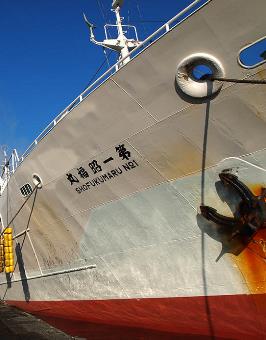Updated 12 August 2020
A Japanese fishery has become the first to achieve certification to the Marine Stewardship Council’s global standard for sustainable fishing for bluefin tuna.
The certification follows a two-year assessment. This included an objection process that concluded when an independent legal expert, Eldon Greenberg, decided a concern raised by WWF about bluefin tuna maturity rates had been dealt with by an updated action plan.
These findings paved the way for the fishery - Usufuku Honten - to receive certification. This is a significant moment in the turnaround of the Eastern Atlantic bluefin tuna which has been the subject of concerted conservation efforts for the past 20 years.
To be MSC certified, a fishery must show the fish stock is healthy, that it minimises its impact on the environment and has effective management in place.
Eastern Atlantic bluefin tuna was on the verge of collapse less than two decades ago. While fishing never stopped, with allowable catch remaining in the thousands of tonnes, stringent measures introduced in the 2000s led to a significant recovery in numbers in the past decade.
Sotaro Usui, president of Usufuku Honten, said: “We are extremely proud to be the first MSC certified longline bluefin tuna fishery in the world. It means our long-time efforts on bluefin tuna stock management is recognized...Eastern Atlantic bluefin tuna whose stock used to be in decline has been recovering thanks to compliance of strict stock management. We aim to contribute to expanding sustainable fisheries by providing our traceable fishes. We’ve committed to raising awareness and understanding of fishery resources and leaving a legacy of Japanese traditional fishing and healthy bluefin tuna stocks for future generations to enjoy.”
The MSC’s Chief Science and Standards Officer, Dr Rohan Currey, said, “This certification reflects the positive, concerted action taken over many years, to support the recovery of bluefin in the Eastern Atlantic,” adding that the MSC hoped the certification will raise the importance of sustainably-sourced tuna with Japanese consumers.
The family owned Usufuku Honten fishery entered the assessment process two years ago to help it differentiate itself from the high levels of illegal, unregulated and unreported fishing of bluefin.
While Japanese consumers will have the option to purchase sustainable bluefin tuna, the overall volume available will be relatively small. The fishery entered just a single vessel for the certification assessment. Based in the Canary Islands, Spain, it caught just 55 tonnes of Eastern Atlantic bluefin tuna in 2018 - out of 28,200 tonnes of total allowable catch that year for the area.
 The fishery uses longlines to catch the bluefin tuna, taking just a few weeks in October to fulfil its quota. The bluefin is then shipped to Japan where it is consumed as top-quality sashimi, a Japanese delicacy of raw slices of fish. At other times of the year the vessel catches bigeye and yellowfin tuna in the central Atlantic.
The fishery uses longlines to catch the bluefin tuna, taking just a few weeks in October to fulfil its quota. The bluefin is then shipped to Japan where it is consumed as top-quality sashimi, a Japanese delicacy of raw slices of fish. At other times of the year the vessel catches bigeye and yellowfin tuna in the central Atlantic.
Established in 1882, the Usufuku Honten fishery began catching tuna around 37 years ago. In 2011 its headquarters, based in Kesennuma, Miyagi prefecture of Japan, were swept away in the tsunami that struck the country’s eastern coastline. It is in the process of constructing a new building on the same plot and currently employs around 200 people and operates seven distant water vessels.
The two-year assessment process included included a six month formal process resolving objections raised by NGOs WWF and The Pew Charitable Trusts. Issues raised included concerns around how the stock is managed by ICCAT, the organisation responsible for the management of tuna in the Atlantic.
The NGOs argued, among other things, that it was premature to certify the stock and that it risked the long-term recovery of bluefin. However, the independent adjudicator asked to consider the objections found this had been adequately addressed through a set of actions the fishery must complete by 2025, but acknowledged that “it was a delicate scientific judgement”.
MSC’s Rohan Currey said that robust contributions from stakeholders such as WWF and The Pew Trust are an essential and welcome part of the independent assessment process and that, “it’s clear from the independent adjudicator’s comments that both organisations have influenced his decision”.
Eastern Atlantic bluefin tuna’s path to certification is all the more extraordinary as its future was in doubt just 15 years ago. A multi-year recovery plan led by the regional fishery management organisation, ICCAT, and backed by conservation activism, agreements on a reduction in the numbers caught and greater scrutiny and reporting of catches, put the Eastern Atlantic bluefin population on to a path for recovery.
By 2014, ICCAT scientists found that bluefin tuna numbers were increasing more quickly than expected and by 2017, assessments indicated the Eastern Atlantic stock was no longer being overfished.
There are three bluefin species in four stocks: Western Atlantic, Eastern Atlantic and Mediterranean, Pacific and Southern, representing just 1% of the world’s tuna catch. Atlantic bluefin tuna capture peaked in the mid-1990s when roughly 50,000 to 61,000 tonnes were caught annually.
The MSC’s Rohan Currey said Usufuku Honten had worked hard to meet the MSC’s high bar of sustainability but added: “We must be mindful that other stocks of bluefin are not in such good shape as the Eastern Atlantic.”
Although all three species of bluefin tuna (Atlantic, Pacific and Southern) have experienced a large decline in the past, bluefin tuna populations are currently on the rise, with the exception of Pacific bluefin tuna. Japan and other governments have backed plans to rebuild Pacific bluefin stocks, with a target of 20% of past historic levels by 2034.
This piece was updated on 12 August 2020, following the fishery’s certification.

-shoal-mediterranean-sea-of-the-coast-of-turkey.jpg?sfvrsn=f234126a_4)